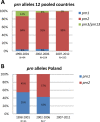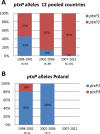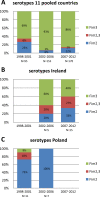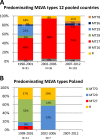Analysis of Bordetella pertussis clinical isolates circulating in European countries during the period 1998-2012
- PMID: 25527446
- PMCID: PMC4365279
- DOI: 10.1007/s10096-014-2297-2
Analysis of Bordetella pertussis clinical isolates circulating in European countries during the period 1998-2012
Abstract
Despite more than 50 years of vaccination, pertussis is still an endemic disease, with regular epidemic outbreaks. With the exception of Poland, European countries have replaced whole-cell vaccines (WCVs) by acellular vaccines (ACVs) in the 1990s. Worldwide, antigenic divergence in vaccine antigens has been found between vaccine strains and circulating strains. In this work, 466 Bordetella pertussis isolates collected in the period 1998-2012 from 13 European countries were characterised by multi-locus antigen sequence typing (MAST) of the pertussis toxin promoter (ptxP) and of the genes coding for proteins used in the ACVs: pertussis toxin (Ptx), pertactin (Prn), type 2 fimbriae (Fim2) and type 3 fimbriae (Fim3). Isolates were further characterised by fimbrial serotyping, multi-locus variable-number tandem repeat analysis (MLVA) and pulsed-field gel electrophoresis (PFGE). The results showed a very similar B. pertussis population for 12 countries using ACVs, while Poland, which uses a WCV, was quite distinct, suggesting that ACVs and WCVs select for different B. pertussis populations. This study forms a baseline for future studies on the effect of vaccination programmes on B. pertussis populations.
Figures







References
-
- Dudman SG, Trøseid M, Jonassen TØ, Steinbakk M. Whooping cough—an increasing problem in Norway. Tidsskr Nor Laegeforen. 2006;126:305–308. - PubMed
-
- Mooi FR, van Loo IH, van Gent M, He Q, Bart MJ, Heuvelman KJ, de Greeff SC, Diavatopoulos D, Teunis P, Nagelkerke N, Mertsola J. Bordetella pertussis strains with increased toxin production associated with pertussis resurgence. Emerg Infect Dis. 2009;15:1206–1213. doi: 10.3201/eid1508.081511. - DOI - PMC - PubMed
MeSH terms
Substances
LinkOut - more resources
Full Text Sources
Other Literature Sources
Medical

